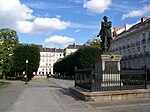Passage Pommeraye
1843 establishments in FranceNantesShopping arcades in FranceShopping malls established in 1843

The Passage Pommeraye is a small shopping arcade in central Nantes, France, named after its property developer, Louis Pommeraye. Construction started at the end of 1840 and was completed on 4 July 1843. The Passage Pommeraye is a passage between two streets, the rue Santeuil and rue de la Fosse, with one 9.40 m higher than the other. Midway, there is a flight of steps and the mall then continues on another floor. Two architects, Jean-Baptiste Buron and Hippolyte Durand Gasselin, contributed to its design, which is very elaborate and includes renaissance style sculptures. The Passage Pommeraye has been classified as a historic monument since 1976.
Excerpt from the Wikipedia article Passage Pommeraye (License: CC BY-SA 3.0, Authors, Images).Passage Pommeraye
Passage Cœur de Nantes, Nantes Centre Ville
Geographical coordinates (GPS) Address Nearby Places Show on map
Geographical coordinates (GPS)
| Latitude | Longitude |
|---|---|
| N 47.213333333333 ° | E -1.5597222222222 ° |
Address
5PM (5PM Store)
Passage Cœur de Nantes
44003 Nantes, Centre Ville
Pays de la Loire, France
Open on Google Maps










